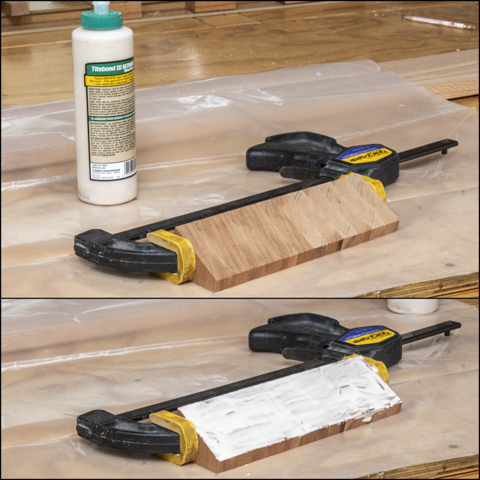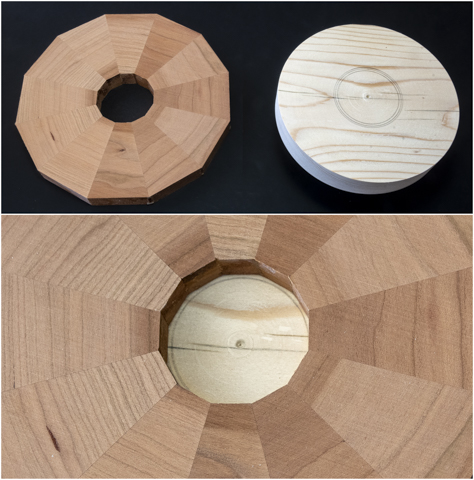The next four layers to be made are much thinner that the
others which presents some different problems.
The drawing below has layers numbered 8 and 10 highlighted in blue. What’s not shown is each of these layers is
made up of two rings, one oak and one cherry layer right at 1/8” thick.
Because these layers are so thin the hose clamp used to
pull the segments together has a tendency to slip off as it is tightened. Getting around that problem required making
the jig shown below. Four spacers just
1/64” taller than the hose clamp’s band gets clamped to the jig. This lets the segments and the hose clamp
move around as the hose clamp gets tightened but keeps the hose clamp from
riding up and popping off the segments.
The right photo is a little closer view.
Another problem with the thin segments is that when the
hose clamp is tightened the segments do not lay flat but get a little
wavy. That’s solved by using a piece of
MDF as a caul after first laying down a sheet of 6 mil polyethylene plastic on
top of the segmented ring. The plastic
keeps the ring from getting glued to the MDF.
With the MDF caul in place, the red handled clamps are snugged down, the
hose clamp tightened and the red handled clamps tightened the rest of the
way. Here is what all that looks like
completed.
Since all four of the layers are the same size, I decided
to cut the segments all at once while the tablesaw jig is setup then do the
four glue-ups using the gluing jig before moving on. The down side is because I let the glue cure overnight it takes four days to glue-up the rings. Once all four all done, they get run though
thickness sander. However, since they
are thin and a bit fragile a carrier with support blocks shown here is used to
support and hold them while being run through the sander. 
Here the four rings are sanded, done and ready to be
glued on.
Gluing on the thin cherry and oak rings are next. They follow the same procedure as the others
with one exception. Since the ring is
somewhat flexible the MDF caul is used (red arrow) to keep the layer flat with the polyethylene
between it and the layer to make sure the MDF and the ring don’t accidently get
glued together. The same process is used
for the next thin oak ring.
Cutting the already made blocks in segments for the four
feature rings takes a little planning so they come out nice and flat when
glued-up. When making the regular rings
the board is flipped top to bottom after each cut. In the photo below you can see the cutting
jig on the table saw with one piece cut and three cut pieces lined up near the
bottom. When these pieces are assembled
into a ring, they will lay flat even if the saw blade is not absolutely set at
90 degrees to the table because if there is an error it gets cancelled out by
the way the segments are cut. Bear with
me for a bit as I go through how this works and why it’s important when cutting
the segments for the feature rings.
As much as I try, I know the table saw blade is not
absolutely perfectly 100% square with the table. It’s very close, close enough so I can’t
measure an error when making a cut.
However, because the rings are made from 12 segments there are 24 cuts
and any error when making a cut gets multiplied twenty-four times so a really
small error gets magnified a lot. As an
example, let’s assume that the blade is off an exaggerated amount of say 10
degrees like in the drawing below. When
the end cut is made as in the bottom photo the edge of the segment ends up with
the jig’s 15-degree angle plus the 10 degrees the saw is out of square.
Next the board is flipped top to bottom, slid over to the
stop and the segment is cut to length which is the piece to the right of the
saw blade in the top drawing below. This
piece’s edges are not square and do not have parallel edges. To make the second segment the board is
flipped top to bottom and then the second segment is cut with the results shown
in the middle drawing below. Last is to
flip the just cut segment top to bottom which is shown in the bottom drawing. Now when the two cut pieces are glued
together the angled edges of the segments cancel each other out resulting in a
flat glue up.
This method only works when the segments get cut from a
continuous board but the feature rings are not made from a continuous board,
they will be made from the already rough sized individual blocks. 
The first segment follows the same process as the ones in
the regular rings. First, one end is
trimmed using the jig to make the 15-degree angle shown in the top photo. If you look in the saw slot in the jig you
can just see a line that represents the cut of the hypothetical 10-degree out
of square saw blade. The piece is then
flipped top to bottom and the other end cut to make the tapered segment (bottom
photo). On the vertical face the pencil
lines show how the piece would look like a wedge. Now if the next piece were cut the same way
that wedge shape would compound and not cancel out. The result is when the segments glued
together a shallow cone would be created rather than a flat ring.
In order to make a segment with complimentary angles to
the first one I need to reverse the cuts or make the first cut with the blank’s
bottom face up rather than down like the first one. That setup is shown in the top photo. Note that this blank has the maple side up rather than the previous piece which started with the cherry face up. After the first cut the blank is flipped top
to bottom and the second cut made per the bottom photo.
Put side by side you can see when the cuts are made as
described above the adjoining faces (red arrows) will cancel out any minor
variances from a non-square saw blade.
The result is a self-compensating joint that will mesh creating a flat
glue-up. Now all I need to do is make
sure that all the even numbered blanks are cut one way and the odd numbered
ones the other.
Next Up – Making Feature Ring Segments











































